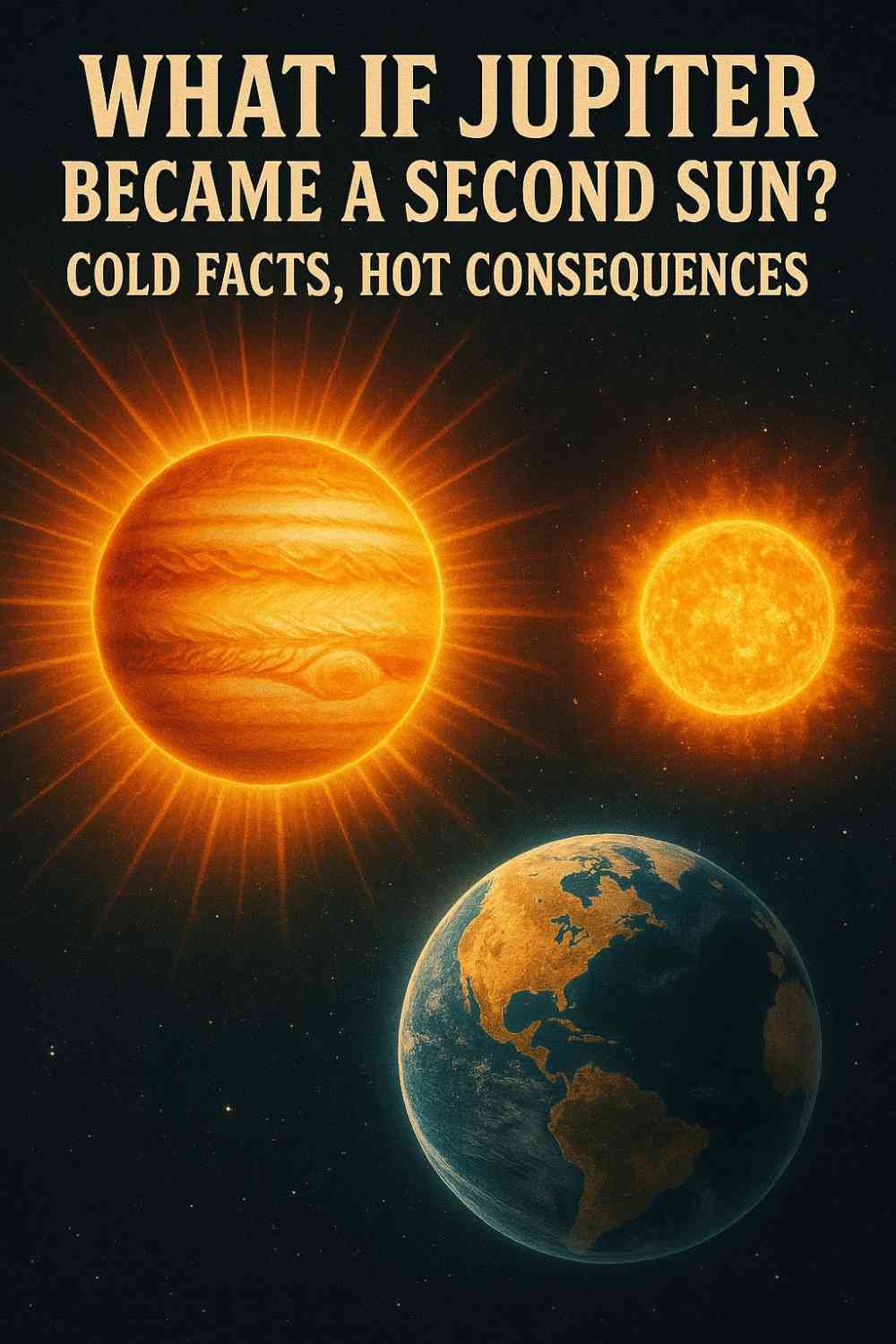Let’s play with the wild idea that keeps sci-fi fans grinning and astronomers twitching: Jupiter lights up. Not just “a little brighter than usual,” but glowing like a sun. What actually happens to Earth, the night sky, our weather, and the rest of the solar system? Here’s the short answer nobody likes but everyone needs: physics is not amused. The long answer is where the fun (and the danger) lives.
First: Could Jupiter Actually Ignite? 🔬
Cold fact: No, not as it is. To become a star, a body needs enough mass to crush its core until nuclear fusion kicks in. Hydrogen fusion—the stuff of real stars—takes roughly 75–80 Jupiter masses. Jupiter weighs in at one Jupiter mass (helpful name, terrible résumé).
There’s a halfway house in starland: brown dwarfs, which can briefly burn deuterium with ~13 Jupiter masses. Still too heavy for our Jupiter. So, naturally speaking, Jupiter is a gas giant, not a star-in-waiting.
But “naturally speaking” wasn’t the assignment. So let’s run three thought experiments that climb the ladder from plausible-ish to full fever dream.
Scenario A: The “Warm Jupiter” — A Dim Brown Dwarf 🔥🟤
Imagine Jupiter somehow gains enough mass to become a low-end brown dwarf—no full hydrogen fusion, just a faint, ember-like glow. From Earth, what changes?
Brightness at Earth: Brown dwarfs are dim—thousands to millions of times dimmer than the Sun. At Jupiter’s distance (about 5.2 AU), the extra light reaching Earth is a rounding error. Nights stay dark. The Full Moon will still be the show-off.
Climate impact: Essentially none. You wouldn’t notice anything in your backyard thermometer.
Big local drama: The Galilean moons get a front-row seat to trouble. Icy worlds like Europa and Ganymede would heat up. Crusts crack, oceans vent, atmospheres boil off. Io goes from volcanic to “please stop.”
Bottom line: A brown dwarf Jupiter barely nudges Earth but remakes the Jovian system. Great for exogeology, terrible for any hypothetical Europa microbes who wanted a quiet life.
Scenario B: Light Without Weight — Jupiter Shines Like the Sun (But Keeps Its Mass) 💡
Now for a purely hypothetical cheat code: Jupiter starts shining like a Sun-class star without gaining mass. Physics hates this, but it’s a clean way to isolate light effects from gravity.
How much extra light hits Earth?
Inverse-square law time: at 5.2 AU, sunlight is diluted by (1/5.2²) ≈ 1/27. If Jupiter matched the Sun’s luminosity, we’d get about 3.7% of our current solar flux as a bonus.
Climate translation: That extra energy, after you average it out and account for reflection, would plausibly push global temperatures up by ~7°C over time. That’s not a gentle nudge; that’s a shove. Think ice sheets in retreat, sea levels up, heat extremes normalizing, and climate belts marching poleward.
Nights? Not really. When “Jupiter-Sun” rises while our Sun sets (roughly once every 13 months at opposition), night would look like a pale day for weeks. Not noon-bright, but bright enough to read outside, grow some plants, and blow up every nocturnal ecosystem on Earth. Sleep cycles go weird. Migratory cues scramble. Baby turtles lose their minds.
Weather patterns: Extra energy means a juiced-up water cycle—more evaporation, stronger storms, rearranged monsoons. Not everywhere, not all at once, but the deck is reshuffled.
Auroras & space weather: A second solar wind means more chances for magnetospheric squabbles. Expect frequent, brighter auroras when the two “suns” line up to squeeze Earth’s magnetic bubble.
Bottom line: With light alone, Earth warms a lot and nights partly disappear on a roughly yearly schedule. Civilization adapts, but nature pays.
Scenario C: The True Binary — Jupiter Gains Stellar Mass 🌗⚖️
Now we go full send: Jupiter bulks up to a small star—say 0.1 solar masses—and actually fuses hydrogen. That changes everything.
A wobbling solar system: The Sun and “Jupiter-Star” orbit a common center of mass roughly 0.4–0.5 AU from the Sun. Planetary orbits don’t just “keep calm and carry on.” Resonances shift. The asteroid belt destabilizes, and the comet flux into the inner system spikes. Planetary defense goes from “nice to have” to “fund the sky lasers today.”
Earth’s orbit: Likely remains bound to the Sun (we’re still talking 10:1 mass ratio), but our orbital elements—eccentricity, inclination, precession cycles—get a rewrite. You get climate variability on top of the baseline warming from Scenario B if luminosity is comparable.
Two shadows, two seasons: Eclipses and conjunctions get complicated. Double shadows cast strange twilight geometry. Growing seasons become a calculus problem with two light sources and shifting daylength equivalences.
Outer system: rebranded. The realm beyond Mars becomes a hostile construction zone of migrating rocks and melting ice worlds. Europa’s surface cracks like sugar glass. Callisto grows a temporary atmosphere, then loses it. Saturn’s rings darken and warp under changing radiation and micrometeor rates.
Bottom line: The gravitational redo is the real hazard. Humanity adapts to brighter nights; it’s the uptick in impacts and orbital chaos that keeps mission control awake.
How Bright Are We Talking, Exactly? 🔭
A few anchoring numbers help:
Current Sun at Earth: ~1361 W/m² at the top of the atmosphere (call this 100%).
Sun-bright Jupiter at Earth: ~3.7% extra at the top (because 1/27th). After reflection and averaging, that still translates to a big radiative forcing. That’s your ~7°C long-term bump.
Brown dwarf Jupiter at Earth: A tiny fraction of a percent. You won’t tan by “Jupiter-light.”
For human experience, think illuminance: Daylight on a clear noon is ~100,000 lux. If Jupiter were Sun-bright and positioned opposite the Sun, you’d get thousands of lux at “night”—like a heavily overcast day. City planners? Ecologists? Astronomers? Everybody’s plans get redlined.
Life Under Two Suns: Ecological Whiplash 🌱🦉
Plants: Many crops respond to photoperiod. A second sun during “night” extends the effective day. Some species surge; others fail to flower. Farmers lean on new cultivars and blackout nets. Greenhouses? They party.
Animals: Nocturnal predators lose cover. Prey behavior rewires. Migratory birds relying on starlight and skyline cues get disoriented. Sea turtles and shorebirds follow the wrong lights. Expect boom-and-bust population swings for a generation or two.
Humans: Sleep medicine becomes a growth industry. We redesign street lighting, architecture, and shift work. Energy use drops during bright nights; air conditioning costs rise in hotter summers. Tourism invents “double-sunset safaris.”
Geopolitics & Culture: Calendars, Cities, and New Rituals 🗺️🏙️
The “Opposition Season”: Every ~13 months, when the second sun dominates the midnight sky, cities host night markets, all-night sports, and 24/7 festivals. Crime stats swing in weird ways—bright nights deter some crimes, enable others.
Religion & art: Two suns rewrite symbolism. Expect fresh architecture that plays with dual shadows and “twin dawn” corridors. Fashion invents sheer-by-day opaque-by-night fabrics.
Global policy: With climate pushed upward and impacts increasing, carbon budgets get squeezed hard. The extra warming from light alone forces faster adaptation and mitigation even if we decarbonize fast.
The Jovian Moons: From Frozen to Furious 🧊➡️🌋
If Jupiter truly glowed like a star, its moons sit uncomfortably close to the furnace—hundreds of thousands to a couple million kilometers away. Even a modestly luminous star roasts them.
Europa & Ganymede: Surface ice sublimates, geysers go global, thin atmospheres form and then get stripped by particle winds. Subsurface oceans surge, then lose heat to space differently, potentially reshaping currents and chemistry.
Io: Volcanism levels up. The plasma torus swells. Juno’s radiation nightmares become everyone’s problem.
Callisto: Once quiet, now weathered by outgassing and micrometeor fireworks.
They’d be the solar system’s must-see disaster documentary.
Astronomy Under a Double Star: Goodbye, Deep Sky? 🌌
Even if the second sun is only occasionally above your horizon at night, its glow murders dark-sky observing across half the year. Professional observatories chase longer “truly dark” windows and push infrared and radio harder. Space telescopes get more important—and more carefully scheduled.
Quick Scorecard (Reality vs. Fantasy) 📖
✅ Plausible (ish): Jupiter as a dim brown dwarf → Earth barely notices; Jovian moons get hammered.
💡 Spectacular but impossible without magic: Jupiter shines like the Sun without extra mass → Earth warms ~7°C, bright “nights” every 13 months, ecosystems scramble.
❌ Catastrophic & chaotic: Jupiter becomes a true small star (gains mass) → orbital mechanics reshuffled, impact risks rise, centuries of celestial turbulence.
Why This Thought Experiment Matters 🔍
It’s tempting to file this under “cool but pointless.” Don’t. It’s a crisp way to feel the levers that run a planetary climate:
A few percent change in sunlight is enough to rewrite weather, agriculture, and coastlines.
Gravity’s architecture matters as much as light—nudge the orbits and you get a different solar system.
“Night” isn’t just dimmer “day.” It’s a biological time signal. Break it and creatures—from plankton to people—pay a price.
If you like this kind of mind-bending “what if,” you’ll love flexing your trivia brain every day. Try the human-curated Bing Homepage Quiz guide or explore the broader Bing Weekly Quiz hub for fresh questions and delightful rabbit holes.
Frequently Asked (Spicy) Questions 🌶️
Would a second sun end winter?
No. Seasons come from tilt, not just brightness. Winters get warmer and shorter in many places, but they don’t vanish.
Could we harvest the extra light?
Yes. Solar output at “night” during opposition turns rooftops into round-the-clock power plants for weeks. Grids would adapt to a 13-month bright-night cycle.
Is this the end of astronomy as we know it?
A setback, not an ending. We shift to space-based telescopes, time windows, and wavelengths less bothered by the glow.
What kills more: heat or rocks?
In Scenario B (light, no extra mass), heat. In Scenario C (true binary), rocks—because the collision rate likely rises as debris fields are stirred.
Final Take 🌍
A second sun sounds romantic until you do the math. The easiest version—a dim, brown-dwarf Jupiter—barely touches Earth but transforms its moons. The flashy version—Jupiter shining like our Sun—makes Earth hotter, stormier, and sleepless for part of every year. The full binary? That’s beautiful and terrifying: a reshaped sky, chaotic orbits, and a civilization learning orbital dynamics the hard way.
Wild idea. Serious lessons. And a deeper respect for the fragile arithmetic that makes Earth feel like home.
